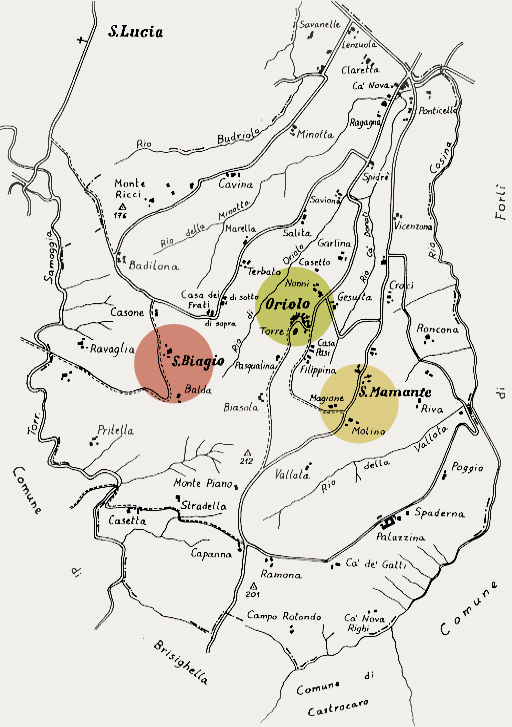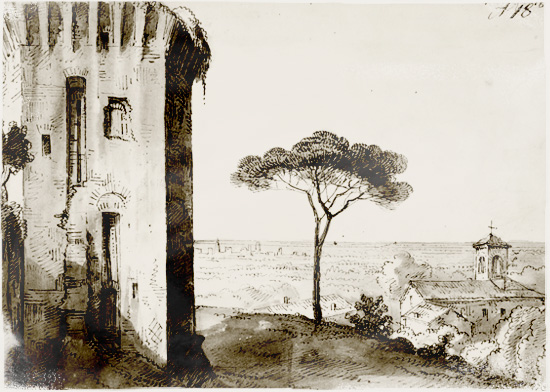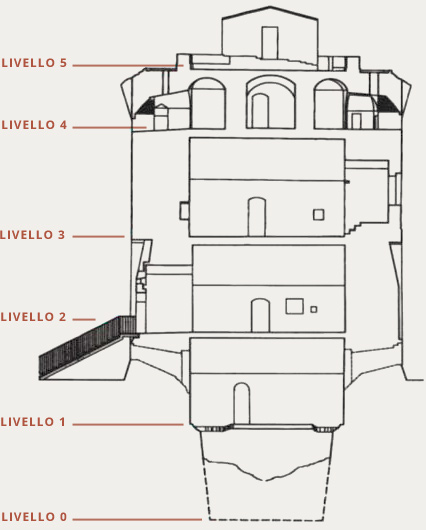The locality
Oriolo dei fichi in a watercolor of Liverani (1840)
Oriolo is a small inhabited center situated on the foothills of the Apennines of Romagna: ten kilometers south-east of Faenza, with an altitude of 141m above sea level. The surrounding land is littered with old farmhouses, is mainly cultivated with vines and arable crops that alternate with wooded escarpments.
The first testimonies of the place we come from far 898 AD, when such an Aghinolfo was the lord.
In 1017 Emperor Henry II gave the Tower to Arnaldo II, Archbishop of Ravenna. It was the latter, forty years later, to build a castle that, throughout the Middle Ages, was fought between the lords of Faenza, Forlì and Ravenna Church, the rightful owner.
From 1300 until 1689, Oriole enjoyed the status of a Rural Municipality: while remaining under the control of those who owned the castle, meant being equipped with a certain administrative autonomy.
At that time the territory of the Municipality of Oriolo had an approximate area of 5-6 kilometers and included three parishes. The population numbered about 500 people that later decreased to the current 200. Of those ancient times, today remains the fifteenth Tower: perched atop a hill and surrounded by a small park owned by the town of Faenza.
The story of the Tower
Begins the 4th January 1474, when Archbishop Bartholomew Roverella ceded the domain of Oriolo to Charles II Manfredi (Lord of Faenza) for the sum of 2500 florins. The old castle was radically restructured and transformed into a fortress for military used: in particular was rebuilt the tower (giving birth to the mighty hexagonal keep that you can still visit today) and fortified access through two thick walls with upper walkways.
In 1500, the fortress was besieged by captain Vitellozzo Vitelli in the pay of Cesare Borgia: finally surrendered and was plundered. The domain of Valentine was short; at the end, the town followed the fate of the rest of Romagna, ending up under the Republic of Venice.
However, in these years the Tower benefited from several renovations and restorations.
With the return of the region under direct papal possession, the fortress of Oriolo and its territory were finally assigned to Faenza. Over time, varied also strategic needs and the military importance of the fortress slowly vanished: was abandoned and that was how the locals used it to recover bricks and other useful materials. Of the fort remained only the tower and a few scattered ruins.
Following the depopulation of the locality and abuse carried out by the directors, at the end of 600 the Papal Legate ordered the suppression of the Municipality of Oriolo, which was reduced to simple Scola: a sort of division of the district with very limited means and powers.
From the second half of the 700, the property of the Tower was ceded to private: used mostly as a dwelling for sharecroppers who worked the surrounding vineyards. For a long time the tower was owned by the family Caldesi.
During the Second World War, in the autumn 1944, the tower served as a refuge for eighty civilians fled from Faenza, for fear of frequent bombings, but was also home to a German garrison which used the tower as a lookout. This made the ancient fortification target of numerous launches of grenades; however, the tower managed to resist thanks to the thick perimeter.
Again abandoned after the end of the conflict: from 1965, the tower was the object of a tenacious sensitization campaign for its restoration and opening to the public. For twenty consecutive years, the inhabitants of Oriolo organized for this purpose the “Spring Festival, for save for a monument.” Therefore, they started negotiations with the family Caldesi, and in 1984 the tower was donated to the city.
Began restoration work of the covered and exterior walls. In 2003 the Municipality of Faenza, with the support of a grant from the Emilia-Romagna region, occupies of the restoration of the interior and finally the Tower was reopened to the public (2004).
Actually, our association in agreement with the Municipality of Faenza looks after the Tower.
The Tower in detail
Of irregular hexagonal shape, with sides long about 8-9 meters, the building is 17 meters high above ground, and other 11 buried.
This particular form is called planimetric double-strut: two tips at right angles and the remaining obtuse angles; so, turning around the Tower this appears time to time square or octagonal depending on the point of view.
The walls are brick, filled with lots of stones and lime mortar, and their average thickness is m. 2.80. The interior consists of six floors.
0. TANK
In the basement: it was used to collect rainwater of the covered through terracotta ductings placed inside the walls; beside, but a lower level, there is the deep drainage ditch. For safety reasons, these rooms are not accessible, but only visible from above.
1. DEPOSITORY OF THE PROVISIONS
In the subbasement: it is a rectangular room with a niche on the back wall inside which are the bread oven and a hole in which threw the waste. From this plan starts the winding stairs, which has as its pivot the well from which drew water from the cistern.
2. GUARD ROOM
Corresponding to the access. Is equipped with two firing positions and a latrine.
3. HALL OF CASTELLAN
In which stands a large fireplace flanked by a latrine and a storeroom.
From this room, through two drawbridges disappeared today, gave access to the walkways.
4. POWDER
At the fifth level, situated near a pentagonal corridor with four crenels for shooting with arquebus. The powder is covered with an interesting vault in bricks arranged in a herringbone pattern.
5. TURRET
Built in the mid-nineteenth century, is located at the height of the spiral staircase. From here, there is access to the large terrace with battlements. La Torre is situated in a dominant position in Faenza, Forlì and Ravenna: for this reason walking on the terrace you can enjoy of 360 ° view over a large part of the Romagna.
Visiting hours of the tower:
From March 15 to October 15:
Every Saturday and Sunday afternoon.
Admission by donation.




